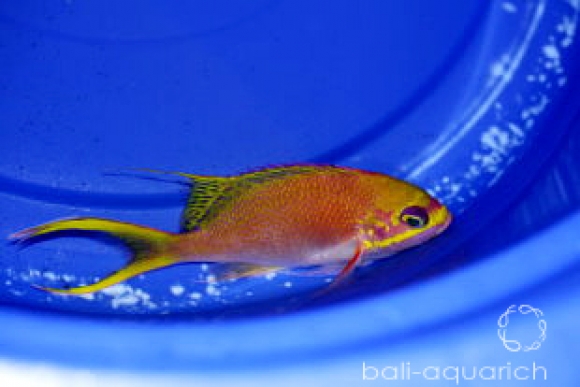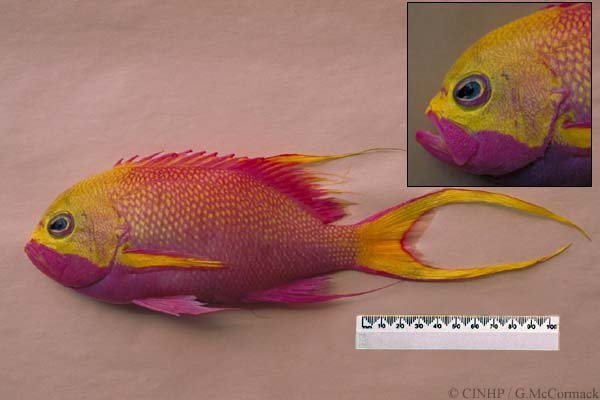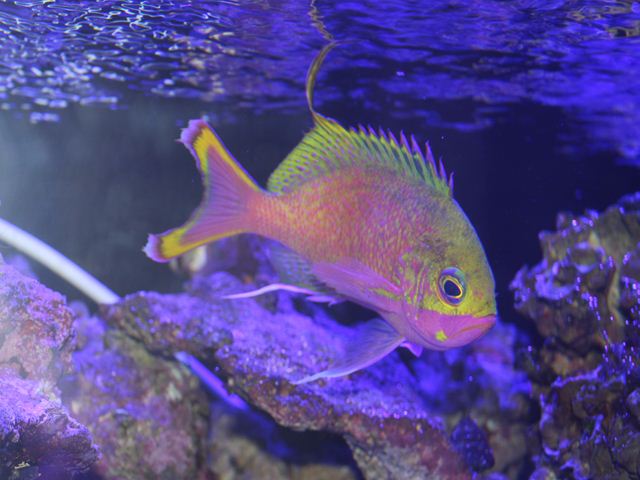For a long time, the confusion between Odontanthias chrysostictus, O. katayamai as well as O. tapui has afflicted many. We’ve made the mistake of wrongly identifying these fishes in the past as well. We hope to straighten out the mistakes and right the wrong and hopefully shed some light on these very similarly colored and closely related Odontanthias. The fish headlining this post from BlueHarbor is O. katayamai.
O. katayamai, except for the caudal fin, is nearly identical from O. chrysostictus. In O. katayamai, the caudal fin has a deep “U”-shaped concavity that ends in two lobed tips. This unique tail shape is seen in another Odontanthias species, and it is none other than the deepwater Hawaiian O. fuscipinnis. Like O. chrysostictus, O. katayamai has its soft dorsal fins and filaments colored yellow. Its type locality includes Guam and Japan, where it has only been collected in the latter locale. There are three known specimens of O. katayamai that we know of and are traceable currently. One in Japan at Deep Sea Challengers, one in Okinawa public aquarium, and the other in Koji Wada’s customer’s tank.
Here is a video of the current O. katayamai sharing a tank with a Selenanthias analis, also rare in the deepwater basslet market.

Next is the highly similar O. chrysostictus. For a long time, both O. katayamai and O. tapui have been masquerading conveniently under the name of O. chrysostictus. As the differences are not easy to pick out at first, many times the fish is mistakenly identified as this, and soon every deepwater yellow-masked Odontanthias is identified as O. chrysostictus. O. chrysostictus type locality is from Indonesia, and has never been collected outside of this range. There has only been one confirmed specimen caught for the aquarium trade by Bali-Aquarich, but it never managed to survive the capture and stress.
Having said that, all previously labelled “O. chrysostictus” from japan are now null, and are O. katayamai. As mentioned before, both species are highly similar except for the caudal fin. In O. chrysostictus, the caudal lobes are elongated and tapered, and are colored yellow. There are minute differences in the facial markings, and in this species, an oblique purple band is seen joining the base of the eye to the pectoral fin base. It is also noteworthy of mention that both O. katayamai and O. chrysostictus possess yellow soft dorsal fins and dorsal filaments.

The last member of the confusing trio is O. tapui. O. tapui is the rarest of the trio and has never been made available to the aquarium hobby as of yet. This species possess a complete yellow mask on its face that is unbroken by any oblique bands. It’s soft dorsal fin is entirely violet and not yellow, as seen in the previous two species. However, the dorsal filaments are colored yellow just like the rest. It has the longest and most lunated tail shape of all three species. O. tapui is found in the Society and Cook islands, far away from its two cousins O. chrysostictus and O. katayamai.
In summary, the three species can be differentiated by the following main keys.
Head
- – O. katayamai: Completely yellow head unbroken by any purple bands
- – O. chrysostictus: Yellow head broken by an oblique purple band joining the base of the eye to the base of the pectoral fin
- – O. tapui: Completely yellow head unbroken by any purple bands
Dorsal Fin
- – O. katayamai: Soft dorsal fin and filaments colored yellow
- – O. chrysostictus: Soft dorsal fin and filaments colored yellow
- – O. tapui: Soft dorsal fin colored violet, filaments colored yellow
Tail
- – O. katayamai: Tail is deeply U-shaped with lobed filaments.
- – O. chrysostictus: Tail is emarginate, long and tapering. Colored yellow.
- – O. tapui: Tail is highly emarginate, long and tapering. Colored yellow.
Geographical distribution
- – O. katayamai: Known so far from Guam and Japan, may have its range extended in the future with deep sea exploration. Caught and exported out of Japan waters as far as we know. Three known specimens for the trade, may be more.
- – O. chrysostictus: Caught and exported out of Indonesia only. One known specimen for the trade.
- – O. tapui: Known from the Society and Cook islands, where none have been available for the trade.



